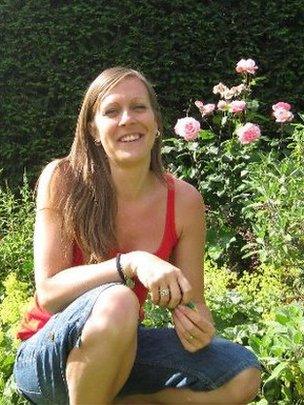Home therapy is key to 'normal life' with HAE
- Published

Unexplained swellings, excruciating pain and days spent vomiting or in bed.
These were the kind of symptoms Rachel Annals from Somerset experienced once or twice a week during her childhood.
It was only after many years of tests, at the age of 15, that her illness was finally given a name - Hereditary Angioedema (HAE).
"We'd never even heard of it," Rachel says.
Few people have, even doctors. HAE is thought to affect one in 50,000 people in the UK, but half of those go undiagnosed.
Dr Hilary Longhurst, a consultant immunologist at Barts and the London NHS Trust and head of the biggest HAE clinic in the country, says it is a much misunderstood condition.
"People don't understand it and how important it is to treat it.
"But treatment can be the difference between intermittent disablement and a normal life."
Rachel has now traced the condition back through her dad's side of the family.
"Dad and Grandma only rarely have attacks, but great-grandma had really serious swellings. Her top lip used to swell up badly."
The swellings (or oedema) which characterise HAE occur most notably in the hands, feet, face, throat and abdomen.
They can start at any time from early childhood to later in life, vary in frequency from just a few a year to every few days, and last from three to five days.
Abdominal pain is caused by the bowel swelling and blocking, and can cause sickness, diarrhoea and severe pain.
Throat or facial swellings can be life-threatening if the airways become blocked.
Rachel remembers getting abdominal cramps regularly during her school years and having to take time off to recover.
But the swelling was not always visible and often she suffered in silence.
'I could hardly breathe'
Now, at the age of 34, she can feel the attacks coming.
"Quite often I get a rash like rings on my chest, or my skin gets itchy at the sight where a swelling later occurs.
"Then I get a severe cramping pain, like someone is twisting your stomach. It starts as rumbly and achy, then becomes really tender to touch," Rachel says.
Sometimes her hand swells up so much that she can't hold a knife and fork.
"The pain of the skin stretching is like a burning pain."
"I also get weird swellings in my knee or hip joint now which makes it difficult to walk."
Only once has she had a severe throat swelling.
"I was 19 and at college. It started with a throat infection. Within three or four hours, I could hardly breathe. It wasn't nice."
HAE has had a huge impact on her life. She was on steroids for 17 years, which helped control the condition, but there were serious side effects.
Warning signs
In 2010, Rachel was prescribed a different kind of therapy which boosts levels of a blood protein called C1 inhibitor, which is lacking in people with the condition.
It is given by an injection into the vein, and stops the progress of an attack.
C1 inhibitors raise the level of a blood protein lacking in people with HAE because of a genetic defect.
People with the condition can be taught to administer the treatment at home.
But that is not available in her local area, so Rachel has to visit her local hospital every time she has an attack to receive the injection.
Dr Longhurst believes that this adds to the stress of people already in pain.
"The vast majority of people can be taught to administer the C1 inhibitor themselves at home, as and when the attacks occur. They can see the warning signs."
HAE experts and patient support groups say this will save the NHS money in the long term - and help people recover more quickly.
Ann Price, from East Sussex, was the first patient in the UK to have the injections in the 1980s.
The HAE gene has passed to all three of her children, and two of her grandchildren.
Yet she says they all have a very good quality of life thanks to a home therapy program.
"My two children developed frequent attacks in their mid-teens. They couldn't have gone to university or travelled the world, or achieved in their careers, if they had untreated HAE."
Ann's oldest granddaughter has had severe attacks every 10 days or so since she was three, but being treated at home means she can also enjoy a full and happy life.
'The black cloud'
But not everyone has access to the same level of treatment or expertise.
Ann knows of people who have had their appendix taken out and even a kidney removed because doctors misdiagnosed HAE.
Rachel often has to change arrangements at the last minute due to an attack.
"I have to make sure I'm never too far from a hospital.
"Work are flexible and I can make up the time. I don't know how I would cope without that.
"If I could do the treatment myself, I could avoid a lot of pain and distress. It's quite frustrating, really."
Dr Longhurst recalls when HAE was referred to as 'the black cloud', when no treatment existed and when families were afraid of talking about it and confronting the condition.
Science has provided the answers, but she says not everyone can benefit from them.
- Published1 February 2012
- Published25 October 2011
- Published31 May 2011
- Published6 April 2011